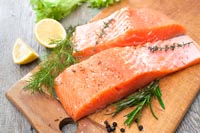New Year's resolutions don't have to be intense, hard-to-achieve dreams. In fact, they shouldn't be! Studies have shown that setting small goals is actually more effective for creating lasting change, which is exactly what you want when it comes to improving your health. The American Psychological Association suggests changing only one behavior at a time. So, instead of trying to focus on implementing a bunch of healthy changes all at once, start by evolving just one behavior in January. Add the next behavior modification in February, and so on. Also, remember that it takes time and repetition to develop a new behavior. Just the term "New Year resolution" can sabotage people into subconsciously believing that the changes they make at the start of the year are just that - only at the start of the year. Instead, try thinking of your resolutions as "new you evolutions." This will help you commit to the changes you are making as a new and improved lifestyle, rather than a short-term solution to a problem.
Here are 5 small-but-mighty steps to get you started on your health evolution.
1. Redefine your plate. This means control portion sizes and embrace the two-thirds rule. Modern portion sizes are grossly out of touch with what our bodies actually require to live and thrive. You might try using smaller plates or measuring tools to help you control your portion sizes. And, a healthy, balanced plate should be covered with two-thirds of green, meaning healthful, fresh vegetables of some sort. The other third, should contain your protein and a small amount of complex carbs. Save the fruit for breakfast, snack or dessert.
2. Treat your body to plenty of H2O. You're body loves water! In fact, it is made almost entirely of water. And just like any body of water, your body requires a steady flow of water to avoid dehydration. Just how much water you actually need depends upon your weight. Multiply your weight by two-thirds or 67%. The product of that equation is roughly how much water you should take in daily. To help you meet this goal, try drinking a 16 ounce glass of water before every meal. As a bonus, this practice will also help you feel full and help you to control your eating. You might also try sneaking in a couple of glasses in the morning, and another before bed. Keeping track of your intake can be made easier by using a specified water bottle or source container.
3. Add 30 minutes of exercise daily. If you're not already an active person, start small. This could be as simple as taking a brisk walk through your neighborhood, stretching shortly after waking, and taking the stairs anywhere you go. All of these things will help get your blood flowing throughout the day, and will help you easily fit exercise into your schedule. After a couple of weeks of daytime warm-up, or if you're already an athletic person, find other activities to give yourself a more challenging workout. Always check with your doctor before beginning a new exercise routine.
4. Get a boost with supplements. While it's best to get your vitamins from natural sources, it might behoove you to go the extra mile with supplements. Although many supplements can be found over-the-counter, each person is different will do best with an individualized supplement regimen. Talk to Dr. Bossio about what supplements are the most beneficial for you.
5. Catch some zzzzzs. Sleep is one of the best things you can possibly do for your health. Sleep helps reduce cortisol and stress levels, while allowing your body time to recharge. Whether sitting at a desk all day or actively taking life by the horns, we all need plenty of sleep. The general rule of thumb is 8-10 hours of restful sleep per night.
REFERENCES
Making Lifestyle Changes that Last. American Psychological Association.
Murray, N.D., Michael, and Pizzorno, N.D., Joseph. 2012. New York, NY: Atria Paperback. The Encyclopedia of Natural Medicine.
Image Attribution: Gustavo Frazao/bigstock.com



















